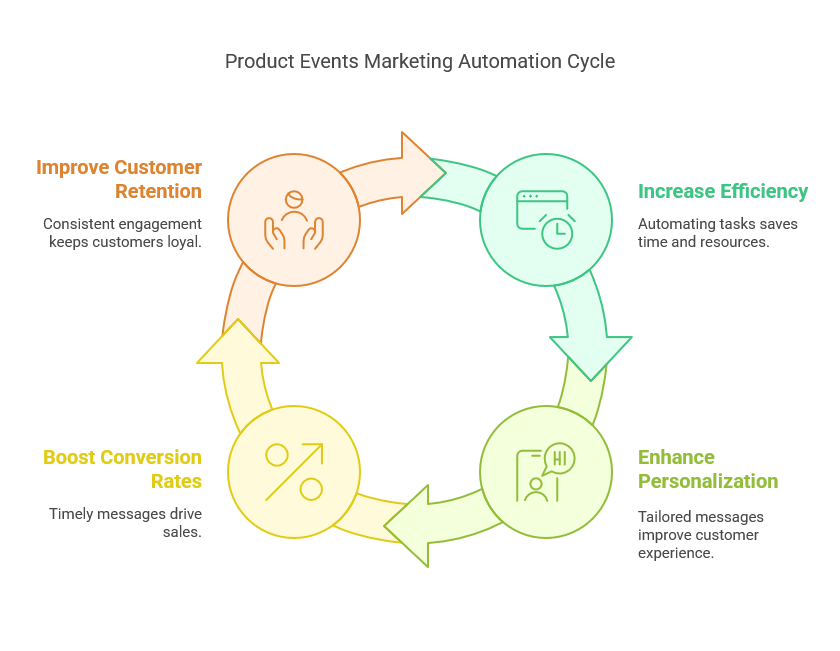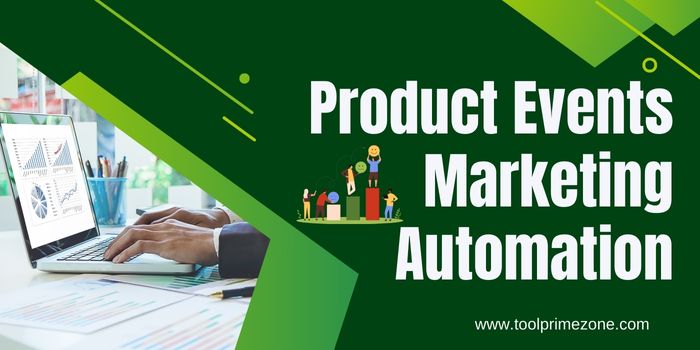Product events marketing automation is essential for businesses looking to streamline their marketing efforts. It allows companies to respond to customer behavior and actions in real time, ensuring that the right message reaches the right person at the right time. Businesses can engage customers more effectively by automating marketing responses to specific product events, improving conversions and enhancing the customer experience. This post will explore how product events marketing automation works, its benefits, and how businesses can implement it successfully.
What is Product Events Marketing Automation?
Product events marketing automation uses automated systems to trigger marketing actions based on specific customer events or behaviors. These events include purchasing, signing up for a newsletter, clicking a link, or interacting with a product feature. Instead of manually sending out emails or SMS messages in response to these actions, marketing automation software handles the process automatically.
For example, when a customer purchases, an automated system can send a confirmation email, thank-you message, or offer related products. Similarly, if customers abandon their shopping carts, automation can trigger a reminder email to encourage them to complete the purchase.
This form of automation allows businesses to respond to customers instantly, without the need for human intervention. This enhances the customer experience by ensuring timely, relevant, and personalized communication.
Why is Product Events Marketing Automation Important for Businesses?
Product events marketing automation plays a crucial role in modern marketing strategies. As customer expectations continue to rise, businesses need to communicate more efficiently and precisely. Automated systems can respond to customer actions in real time, ensuring that no lead is left behind and that every customer receives the appropriate response based on their actions.
The importance of automation in marketing lies in its ability to:
-
Increase Efficiency: Automating repetitive tasks saves time and resources, allowing your marketing team to focus on more strategic efforts.
-
Enhanced Personalization: Automation ensures customers receive personalized messages relevant to their actions. Customized experiences are more likely to lead to conversions and long-term loyalty.
-
Boost Conversion Rates: Automation can help push leads through the sales funnel and increase conversions by triggering timely, relevant messages.
-
Improve Customer Retention: Automated follow-ups and reminders can help maintain customer engagement and retention by providing consistent communication after a purchase or interaction.

Key Benefits of Product Events Marketing Automation
Product events marketing automation offers many benefits that can help businesses optimize their marketing efforts. Here are some of the key advantages:
-
Streamlined Communication: Automation ensures that customers receive the right message at the right time based on their actions. This minimizes the risk of missing opportunities and provides consistent communication.
-
Improved Engagement: Automated systems allow you to engage customers with targeted, event-driven messages. For example, after a customer makes a purchase, you can send them a thank-you email and recommendations for related products or services.
-
Enhanced Scalability: Automation makes it easier for businesses to scale their marketing efforts. As your customer base grows, you can continue delivering personalized messages without increasing your workload.
-
Increased ROI: Businesses can improve their return on investment by automating routine tasks and optimizing communication. Automation helps reduce the time spent on manual tasks, allowing marketing teams to focus on higher-value activities.
-
Data-Driven Insights: Marketing automation platforms provide valuable data that can be used to optimize campaigns. By tracking customer behavior and the performance of automated workflows, businesses can make data-driven decisions to improve future campaigns.
How Does Product Events Marketing Automation Work?
Product events marketing automation relies on a series of interconnected actions and triggers. Here’s a step-by-step breakdown of how it works:
-
Customer Actions: First, customers take actions tracked by the automation platform. These actions could include signing up for an account, purchasing, interacting with a feature, or abandoning a shopping cart.
-
Event Trigger: The automation system triggers a pre-defined response based on these actions. This could be an email, SMS, push notification, or any other communication that aligns with the business’s goals.
-
Workflow Setup: Businesses set up automated workflows that outline the sequence of actions that should follow a particular event. For example, a workflow for a sign-up event might include a welcome email, a product recommendation, and a special discount for first-time customers.
-
Personalized Communication: The content of these automated messages is personalized based on the customer’s behavior and previous interactions with the business. This ensures that the communication is relevant and timely.
-
Tracking and Optimization: Businesses track their effectiveness once the automated messages are sent. By analyzing customer behavior and the performance of computerised campaigns, businesses can refine their workflows and improve results over time.
How to Implement Product Events Marketing Automation
Implementing product events marketing automation can seem overwhelming, but it doesn’t have to be. Here’s a simple guide to help you get started:
-
Step 1: Choose the Right Marketing Automation Platform
Many marketing automation platforms are available, so it’s important to choose one that aligns with your business needs. Some popular options include HubSpot, ActiveCampaign, and Marketo. These platforms offer a range of tools for creating event-triggered campaigns and automating customer engagement. -
Step 2: Identify Key Product Events
First, you must identify the key product events that will trigger automation. Everyday product events include:-
Sign-ups for newsletters or accounts
-
Completed purchases
-
Cart abandonment
-
Feature interactions
-
Product reviews or feedback
-
-
Step 3: Create Custom Workflows
Next, you’ll need to set up workflows that define how your automation system should respond to each event. For example, if a customer abandons a shopping cart, you might create a workflow that sends them a reminder email or offers a discount. -
Step 4: Personalize the Customer Journey
Personalization is key to the success of product events marketing automation. By tailoring your messages to each customer’s actions and preferences, you can create a more engaging experience that increases the likelihood of conversion. -
Step 5: Monitor and Optimize
Once your workflows are up and running, track their performance to see what’s working and what isn’t. Use analytics to gain insights into how customers interact with your automated messages and make adjustments as needed.

Common Mistakes to Avoid in Product Events Marketing Automation
While product events marketing automation is a powerful tool, it’s essential to avoid some common mistakes:
-
Over-Automating: Too many automated messages can overwhelm your customers. Be strategic about the types and frequency of messages you send to avoid annoying your audience.
-
Not Segmenting Your Audience: Failing to segment your audience can result in irrelevant messages being sent to the wrong people. Use customer data to segment your audience and deliver more targeted, personalized messages.
-
Ignoring Analytics: It’s impossible to know if your automated campaigns are working without tracking their performance. Review analytics regularly and adjust your workflows based on customer behavior and engagement.
Real-World Examples of Product Events Marketing Automation
To better understand how product events marketing automation works, let’s look at some real-world examples:
-
E-commerce: An e-commerce business might use automation to send an email reminder when a customer abandons their cart. If the customer still doesn’t complete the purchase, a discount might be offered to incentivize them to finalize the transaction.
-
SaaS (Software as a Service): A SaaS company could automate onboarding by sending a welcome email when a user signs up. Follow-up emails could be sent to encourage users to explore different software features.
-
Subscription Box Services: Subscription services often use product events to trigger re-engagement campaigns. For example, an email might be sent after a user’s subscription expires, offering them a discount to renew their subscription.
The Future of Product Events Marketing Automation
The future of product events marketing automation is full of exciting possibilities. As AI and machine learning technologies evolve, marketing automation systems will become even more intelligent and capable of delivering hyper-personalized experiences. Businesses will be able to predict customer behavior more accurately and provide even more relevant content in real time.
Product events marketing automation is no longer a luxury; it’s necessary for businesses that want to stay competitive in today’s fast-paced digital world. Companies can improve efficiency, increase engagement, and boost conversions by automating responses to customer actions. With the right tools and strategies, you can create a more personalized, seamless customer experience that drives growth and improves customer satisfaction.

